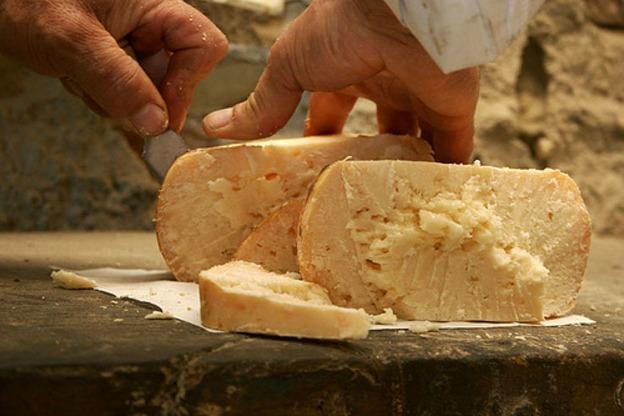Leave it to the Italians to come up with the most bizarre ways to produce delicious food. Such is the case with Formaggio di Fossa, or Fossa cheese, which I discovered during a trip in Romagna late last summer.
Formaggio di Fossa, which literally means “cheese of the pit”, is mainly produced in the town of Sogliano, located about 90 kilometers southeast of Bologna and about 35 kilometers southeast of Forlì. Here, and in a limited nearby area between the Rubicone and Marecchia valleys, are a number of “fosse”, underground caves where the cheese is left to ripen. These caves date back hundreds of years, to the times of the Malatesta dynasty that ruled Romagna from the end of the 13th century to the 17th century.
Originally, the caves were used as granaries. But isn’t that too obvious of an use?! So, at some point, local farmers began to bury cheese. It’s not known why they began this practice, perhaps to hide food when the enemies attacked, or perhaps for storage in case of siege (those were very tumultuous times because many powerful families fought for control over the area). In any case, when the locals took the cheese out, they discovered it had transformed – and that it was very good.
I learned about the history of Formaggio di Fossa from a local producer, the family-run Fossa Pellegrini, who organizes guided tastings preceded by a visit to the small museum they opened in the center of Sogliano, dedicated to the history and practices of Fossa cheese-making.
The key element, I found out, is the sandstone terrain where the pits were excavated, which creates the right temperature and humidity. The pits are carved out of tuff rock and are approximately six meters deep. Every year, at the beginning of August, the pits are opened and local producers (but even just private citizens) bring their cheese to be buried inside. The pits have been prepared in advance, by burning straw inside to eliminate excess humidity and also to sterilize the environment from germs that could harm the fermentation of the cheese. The walls are covered with a 15-centimeter layer of straw to isolate the tuff rock, while wood planks are arranged on the bottom of the pit.
The cheese stays in the pit inside canvas bags until the beginning of November. When it’s taken out, it’s no longer the same cheese that was originally deposited into the pit. It has transformed into “formaggio di fossa”, characterized by a uniquely pungent, slightly bitter taste.
Fossa cheese can be made with cow’s milk, sheep’s milk or a combination of the two. It can be eaten by itself, used in quiches, or grated on pasta – but the unsurpassed combination, I was told, is with honey. Simple yet delicious, as is often the case with Italian food, crazy or not.



